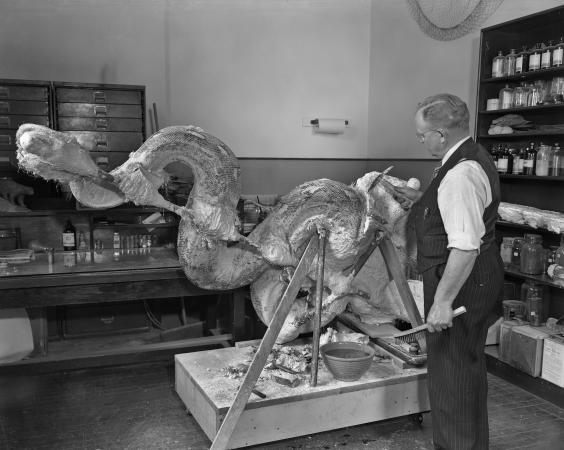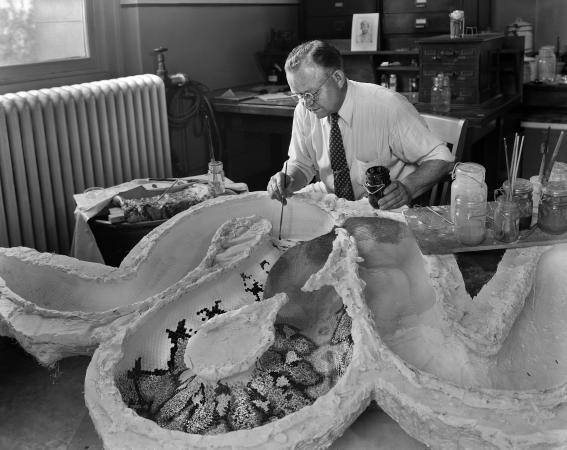As a newcomer to the Smithsonian, I’ve been trying to wrap my head around the Smithsonian’s 172-year history. The stories are always fascinating. Some are downright strange. Many have me making funny faces at my computer screen and mumbling, “Wait. Did that really happen?” Here’s one of those stories.

It was your average Friday at the Smithsonian’s National Museum of Natural History on April 4, 1969. The weather was nice, a little over fifty degrees, and visitors flooded the museum exhibits, as usual. All was well. That is, until a thirty-one-year-old man pulled a hatchet and butcher knife out of a paper bag and began hacking at displays of taxidermied snakes in the Hall of Reptiles and Amphibians. Note to self: never get frustrated by having to go through security in a museum entrance ever again.
But Lampros Marines did not stop at just smashing the Malayan exhibit glass case, which was about six by eighteen feet, and the South American exhibit glass, standing at six by nine feet. No. He proceeded to “kill” the already-dead snake models by decapitating each specimen. Fortunately, the lizards in the cases were spared.
By the time a Smithsonian security officer arrived on the scene, Marines was already packing up and about to leave, clearly satisfied with his day’s work. Before we get to the nitty-gritty of motives and consequences, we’d be remiss not to discuss one of Marines’ victims.
The large python in the Malayan exhibit case lived at the Smithsonian’s National Zoo during World War II. Despite weighing more than 300 pounds, slithering twenty-five feet long, and boasting 100 recurved teeth, the reptile was not poisonous, and could therefore remain at the Zoo during wartime, while the Zoo’s venomous reptiles were sent to the Midwest in case the city was bombed and the snakes escaped.
When the python died in 1944, the Zoo sent the reptile to taxidermist Edgar G. Laybourne to work on for a display at the National Museum of Natural History. Snake taxidermy was relatively new at the time, so Laybourne had a big job ahead of him. A plaster cast was made of the snake’s body, and painted on the inside with a layer of clear cellulose acetate. Once the acetate dried into a hard “skin” layer, it was then carefully painted. Smithsonian ornithologist and wife to Laybourne, Roxie Laybourne, recalled, “E.G. used a dental mirror to paint every scale in reverse.” Roxie Laybourne also expressed relief that her husband, who had died three years prior to the incident, was not around to see the snake damaged, since he would have been heartbroken by its destruction.

Fortunately, no humans were hurt in the snake-smashing episode, but Lampros Marines did have to face the consequences. He was charged with destroying government property and was held under a $5,000 bond.
But why did he do it?
When Smithsonian Captain Wilfred L’Abbe apprehended Marines, he thought the man looked strangely familiar. He sifted through reports from the year prior, and discovered Marines had already attempted to attack the display, but, in that instance, with a long pole. When questioned by the security officer, Marines explained that a snake had stolen $20,000 dollars from him in a poker game and he was simply seeking his revenge.
Although he said it for different reasons, Indiana Jones had the right sentiment. Why’d it have to be snakes?
Related Resources:
- “Crime at the Smithsonian,” by Pamela M. Henson, Smithsonian Institution Archives
- “Man Assaults Snakes in MNH Reptile Exhibit,” by James A. Peters, Smithsonian Torch, April 1969
- “Man Held in Museum Fracas,” Washington Post, April 6, 1969
- “The Object at Hand,” by Adele Conover, Smithsonian Magazine, June 1995
Produced by the Smithsonian Institution Archives. For copyright questions, please see the Terms of Use.

Leave a Comment